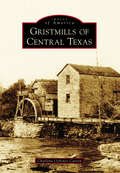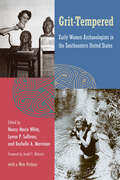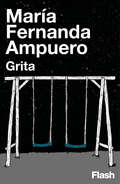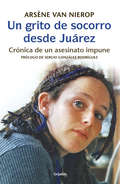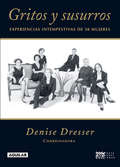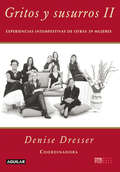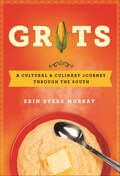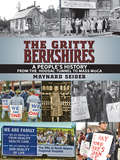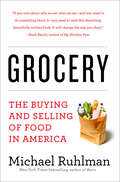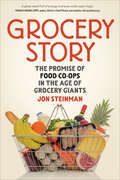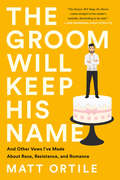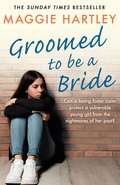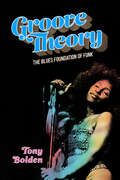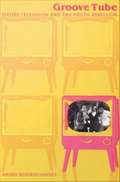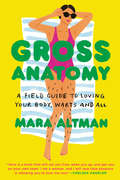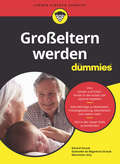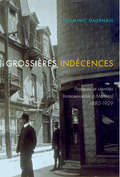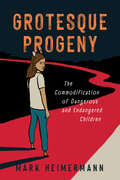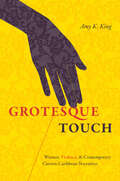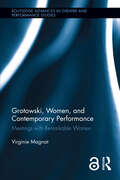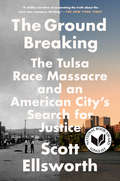- Table View
- List View
Gristmills of Central Texas (Images of America)
by Charlene Ochsner CarsonGristmills were once commonplace in Texas. There was hardly a river, a creek, or a stream without one. The purpose of the gristmill was to grind wheat into flour and corn into meal. Prior to the water-powered gristmill, grinding was a tedious, time-consuming task that was usually performed by hand using some type of mortar and pestle. When a gristmill began operating in an area, settlers from near and far traveled to the mill to have their grain ground. The gathering of these settlers and farmers at the mill was the beginning of many settlements that grew into the Texas towns of today. Many of these picturesque settings have become major tourist destinations.
Grit-Tempered (Florida Museum of Natural History: Ripley P. Bullen Series)
by Nancy Marie White Lynne P. Sullivan Rochelle A. MarrinanThis volume documents the lives and work of pioneering women archaeologists in the southeastern United States from the 1920s through the 1960s. A landmark portrayal of pioneering women in science, reissued on its 25th anniversary Praise for the first edition: “Highly recommended for any archaeologist interested in the history of the discipline.”—Choice “An important addition to the history of southeastern archaeology, bringing to light the often undervalued or forgotten contributions of the many women who helped to make archaeology what it is today.”—Bulletin of the History of Archaeology “This is a needed history, providing details both mundane and critical, personal and professional, feminist and archaeological.”—Journal of the History of the Behavioral Sciences “Demonstrat[es] that each woman, regardless of how, when, or why she came to Southeastern archaeology, has made significant contributions to the field, clearing the path for women today to pursue successful careers in archaeology.”—North American Archaeologist “The regional focus lends an intimate and immediate quality to this series of biographical-historical narratives. . . . [It is] heartening to know that some among us have thought to capture these women’s stories for others to tell in the future and to provide a basis for better understanding how our roles and histories influence our work as archaeologists.”—Journal of Anthropological Research “These fascinating brief portraits, variously based on documents, interviews, or autobiographical statements, reveal much of the changing circumstances in the context of which women’s work must be understood.”—National Women’s Studies Association Journal “A readable book that provides a lot of interesting material on the history of Southeastern archaeology.”—Journal of Alabama Archaeology “A delight to read, often humorous, sometimes sobering. It has much to offer readers, ranging from the history of archaeology and the role of the WPA in southeastern archaeology, to an intimate view of careers of influential women in science, to discussions of the study of gender in history and archaeology. It is a volume to be read and shared.”—Arkansas Historical Quarterly “An easily read, thought-provoking book.”—St. Augustine Archaeological Association Quarterly Book Review Updated with a new preface on the 25th anniversary of its first publication, this volume documents the lives and work of pio
Grita
by María Fernanda Ampuero«Estoy aterrorizada y, sin embargo, no quiero ofenderlo» De niñas, nos enseñan que siempre debemos gustar, ser buenas y agradables. Y la protagonista del relato conoce perfectamente las consecuencias de no gustar, de decir que no al hombre del parque, al hermano de su amiga, a su match de Tinder… En este relato, María Fernanda Ampuero lleva la necesidad de gustar al límite, retratando con crudeza la violencia estructural que sufren niñas y mujeres. «No importa quién seas, siempre eres menos frente a un grupo de hombres»
Un grito de socorro desde Juárez: Cronica de un asesinato impune
by Arsène van Nierop-SeipgensCrónica de un asesinato impune Prólogo de Sergio González Rodríguez ARSÈNE VAN NIEROP "Entre la infinidad de historias de las que el mundo actual dispone, la de Hester van Nierop, por lo que implica el contraste de una vida plena enfrentada a la crueldad más atroz, está llamada a perdurar." SERGIO GONZÁLEZ RODRÍGUEZ, autor de Huesos en el desierto. Hester tenía 28 años de edad en julio de 1998. Vivía con su familia en Holanda: Roeland y Arsène, sus padres; Melisse y Germán, sus hermanos. Partió hacia México semanas después de graduarse en arquitectura para encontrarse con Melisse, quien participaba en un proyecto de protección de tortugas en la costa del Pacífico. Su plan consistía en viajar posteriormente a Estados Unidos para buscar un trabajo temporal. De manera casi inexplicable, decidió hacerlo a través de la peligrosa Ciudad Juárez. Nadie imaginó que las palabras de despedida de sus padres serían las últimas que le dirían: "Adiós, Hester, cuídate mucho, adiós, cariño". Un grito de socorro desde Juárez narra el infierno que la familia Van Nierop sufrió tras el asesinato de Hester en un hotel de la ciudad fronteriza en septiembre de ese mismo año. En un relato inquietante, la tragedia y el duelo personal confluyen con las acciones que Arsène ha llevado a cabo en búsqueda de justicia y contra la ineptitud de las autoridades mexicanas. Las regalías recaudadas por la venta de este libro se destinarán a Casa Amiga, un centro de apoyo para mujeres y niños en Ciudad Juárez.
Gritos y susurros I: Experiencias intempestivas de 38 mujeres (Gritos y susurros #Volumen 1)
by Denise DresserEste libro incluye relatos de 38 mujeres mexicanas quienes explican en qué situaciones se han sentido poco preparadas o han sido tomadas por sorpresa. Libro bestseller escrito por Denise Dresser, una de las analistas políticas más críticas y respetadas en México. Los textos reunidos en este libro dan palabra y voz a 38 mujeres mexicanas de mundos diversos y trayectorias diferentes, reunidas con el afán de contestar a preguntas como: ¿Qué te ha tomado por sorpresa? ¿En qué momentos y frente a qué circunstancias te has sentido poco preparada? a través de textos heterogéneos, las autoras invitan al lector a visitar sus propios momentos de desconcierto.
Gritos y susurros II: Experiencias intempestivas de otras 39 mujeres (Gritos y susurros #Volumen 2)
by Denise DresserUna colección de experiencias de mujeres famosas, compilada por Denise Dresser, una de las analistas más polémicas y críticas de la actualidad. Libro bestseller escrito por Denise Dresser, una de las analistas políticas más críticas y respetadas en México Una reunión de personajes femeninos que dejan al descubierto los pasajes más interesantes de su vida. El primer libro de Gritos y susurros generó entusiasmo y energía porque tejió una comunidad entre quienes lo leyeron, lo comentaron y lo recomendaron; su éxito demostró que las mujeres de México necesitan compartir sus historias, identificarse con ellas. Este libro continúa el ejercicio de libertad iniciado con el primer volumen y convoca nuevamente a un grupo diverso de mujeres -escritoras, actrices, artistas, políticas, funcionarias, empresarias, chefs, cantantes- a contar sus historias. Los textos son aleccionadores y emancipadores. Al leer a estas mujeres, se vuelve fácil reconocer que nos necesitamos las unas a las otras para compartir nuestras experiencias, elaborar nuevas formas de entendimiento, saber cómo somos y cuánto nos falta por hacer, para cargar una antorcha e iluminar el mundo como ellas lo hacen.
Grits: A Cultural & Culinary Journey Through the South
by Erin Byers MurrayGrits is a fascinating cultural history and examination of the current role of grits in Southern cuisine.For food writer Erin Byers Murray, grits had always been one of those basic, bland Southern table necessities—something to stick to your ribs or dollop the butter and salt onto. But after hearing a famous chef wax poetic about the terroir of grits, her whole view changed. Suddenly the boring side dish of her youth held importance, nuance, and flavor. She decided to do some digging to better understand the fascinating and evolving role of grits in Southern cuisine and culture as well as her own Southern identity. As more artisan grits producers gain attention in the food world, grits have become elevated and appreciated in new ways, nationally on both sides of the Mason Dixon Line, and by international master chefs. Murray takes the reader behind the scenes of grits cultivation, visiting local growers, millers, and cooks to better understand the South’s interest in and obsession with grits. What she discovers, though, is that beyond the culinary significance of grits, the simple staple leads her to complicated and persisting issues of race, gender, and politics.
The Gritty Berkshires: A People's History From The Hoosac Tunnel To Mass Moca
by Maynard SeiderAs The Gritty Berkshires makes clear, Massachusetts' westernmost county is not just art museums, music festivals and beautiful scenery. For generations of working class families who have lived in the northern part of this county, their reality looks more like Rust Belt America. Maynard Seider, an activist sociologist who has taught and researched in the area for more than three decades, places the history of the North Berkshire region in the context of U.S. and global history. Through the use of oral histories, union archives, newspaper accounts and participant observation, the author focuses on the 1,000 men who built the nation's longest railroad tunnel, the thousands of men and women who worked in its textile mills and electronics factories and who struck, built worker co-ops, and community coalitions to improve their daily lives. In this history, we learn how the Berkshires offer insight into so many crucial aspects of the American experience. Moving from the early 1800s to the present, Seider weaves a narrative that details the area's vibrant immigrant history, slavery's role in its textile industry, the battle for national unions and the ideological struggles with corporate elites over who best speaks for the community. Enriched by dozens of photographs, these stories focus on the voices of ordinary people as they often do extraordinary things. Seider concludes his book by considering the question of "What's next?" through a case study of the Massachusetts Museum of Contemporary Art (MASS MoCA). These brick buildings which housed generations of blue and white collar workers until 1986 now attract tourists to the country's largest contemporary art collection. Yet the unanswered question remains, can a tourist-service economy provide a meaningful and economically sustainable life for its residents? The Gritty Berkshires' last section deals with this question both nationally and locally, exploring diverse responses amidst the nation's growing inequality, militarism and cutbacks in social services.
Grocery: The Buying and Selling of Food in America
by Michael RuhlmanThe New York Times–bestselling author “digs deep into the world of how we shop and how we eat. It’s a marvelous, smart, revealing work” (Susan Orlean, #1 bestselling author).In a culture obsessed with food—how it looks, what it tastes like, where it comes from, what is good for us—there are often more questions than answers. Ruhlman proposes that the best practices for consuming wisely could be hiding in plain sight—in the aisles of your local supermarket. Using the human story of the family-run Midwestern chain Heinen’s as an anchor to this journalistic narrative, he dives into the mysterious world of supermarkets and the ways in which we produce, consume, and distribute food. Grocery examines how rapidly supermarkets—and our food and culture—have changed since the days of your friendly neighborhood grocer. But rather than waxing nostalgic for the age of mom-and-pop shops, Ruhlman seeks to understand how our food needs have shifted since the mid-twentieth century, and how these needs mirror our cultural ones.A mix of reportage and rant, personal history and social commentary, Grocery is a landmark book from one of our most insightful food writers.“Anyone who has ever walked into a grocery store or who has ever cooked food from a grocery store or who has ever eaten food from a grocery store must read Grocery. It is food journalism at its best and I’m so freakin’ jealous I didn’t write it.” —Alton Brown, television personality“If you care about why we eat what we eat—and you want to do something about it—you need to read this absorbing, beautifully written book.” —Ruth Reichl, New York Times–bestselling author
Grocery Activism: The Radical History of Food Cooperatives in Minnesota
by Craig B. UprightA key period in the history of food cooperatives that continues to influence how we purchase organic food today Our notions of food co-ops generally don&’t include images of baseball bat–wielding activists in the aisles. But in May 1975, this was the scene as a Marxist group known as the Co-op Organization took over the People&’s Warehouse, a distribution center for more than a dozen small cooperative grocery stores in the Minneapolis area. The activist group&’s goal: to curtail the sale of organic food. The People&’s Warehouse quickly became one of the principal fronts in the political and social battle that Craig Upright explores in Grocery Activism. The story of the fraught relationship of new-wave cooperative grocery stores to the organic food industry, this book is an instructive case study in the history of activists intervening in capitalist markets to promote social change.Focusing on Minnesota, a state with both a long history of cooperative enterprise and the largest number of surviving independent cooperative stores, Grocery Activism looks back to the 1970s, when the mission of these organizations shifted from political activism to the promotion of natural and organic foods. Why, Upright asks, did two movements—promoting cooperative enterprise and sustainable agriculture—come together at this juncture? He analyzes the nexus of social movements and economic sociology, examining how new-wave cooperatives have pursued social change by imbuing products they sell with social values. Rather than trying to explain the success or failure of any individual cooperative, his work shows how members of this fraternity of organizations supported one another in their mutual quest to maintain fiscal solvency, promote better food-purchasing habits, support sustainable agricultural practices, and extol the virtues of cooperative organizing. A foundational chapter in the history of organic food, Grocery Activism clarifies the critical importance of this period in transforming the politics and economics of the grocery store in America.
Grocery Story: The Promise of Food Co-ops in the Age of Grocery Giants
by Jon SteinmanHungry for change? Put the power of food co-ops on your plate and grow your local food economy. Food has become ground-zero in our efforts to increase awareness of how our choices impact the world. Yet while we have begun to transform our communities and dinner plates, the most authoritative strand of the food web has received surprisingly little attention: the grocery store—the epicenter of our food-gathering ritual.Through penetrating analysis and inspiring stories and examples of American and Canadian food co-ops, Grocery Story makes a compelling case for the transformation of the grocery store aisles as the emerging frontier in the local and good food movements. Author Jon Steinman:Deconstructs the food retail sector and the shadows cast by corporate giantsMakes the case for food co-ops as an alternativeShows how co-ops spur the creation of local food-based economies and enhance low-income food access.Grocery Story is for everyone who eats. Whether you strive to eat more local and sustainable food, or are in support of community economic development, Grocery Story will leave you hungry to join the food co-op movement in your own community.
The Groom Will Keep His Name: And Other Vows I've Made About Race, Resistance, and Romance
by Matt OrtileA riotous collection of "witty and captivating" (Bitch Magazine) essays by a gay Filipino immigrant in America learning that everything is about sex--and sex is about powerWhen Matt Ortile moved from Manila to Las Vegas, the locals couldn't pronounce his name. Harassed as a kid for his brown skin, accent, and femininity, he believed he could belong in America by marrying a white man and shedding his Filipino identity. This was the first myth he told himself. The Groom Will Keep His Name explores the various tales Ortile spun about what it means to be a Vassar Girl, an American Boy, and a Filipino immigrant in New York looking to build a home. As we meet and mate, we tell stories about ourselves, revealing not just who we are, but who we want to be. Ortile recounts the relationships and whateverships that pushed him to confront his notions of sex, power, and the model minority myth. Whether swiping on Grindr, analyzing DMs, or cruising steam rooms, Ortile brings us on his journey toward radical self-love with intelligence, wit, and his heart on his sleeve.
Groomed to be a Bride (A Maggie Hartley Foster Carer Story)
by Maggie HartleyA heartbreaking, powerful true story from Britain's most-loved foster carer, perfect for fans of Cathy Glass and Casey Watson.When a terrified young girl is discovered hiding in the back of a lorry, she is quickly taken into the care of social services. Arriving on the doorstep of foster carer Maggie Hartley, she is painfully thin, bruised and unable to speak a word of English. What atrocities has she escaped to bring her here? Woken each night by the screams of Halima's nightmares, Maggie is desperate to reach this damaged young girl. But without a shared language, she fears that she may never uncover the truth behind her terror.Can Maggie help Halima recover from the horrors she has endured, and help her build a new life for herself? Or will Halima forever be haunted by the ghosts of her past?
Groomed to be a Bride
by Maggie HartleyA heartbreaking, powerful true story from Britain's most-loved foster carer, perfect for fans of Cathy Glass and Casey Watson.When a terrified young girl is discovered hiding in the back of a lorry, she is quickly taken into the care of social services. Arriving on the doorstep of foster carer Maggie Hartley, she is painfully thin, bruised and unable to speak a word of English. What atrocities has she escaped to bring her here? Woken each night by the screams of Halima's nightmares, Maggie is desperate to reach this damaged young girl. But without a shared language, she fears that she may never uncover the truth behind her terror.Can Maggie help Halima recover from the horrors she has endured, and help her build a new life for herself? Or will Halima forever be haunted by the ghosts of her past?
Groove Theory: The Blues Foundation of Funk (American Made Music Series)
by Tony BoldenTony Bolden presents an innovative history of funk music focused on the performers, regarding them as intellectuals who fashioned a new aesthetic. Utilizing musicology, literary studies, performance studies, and African American intellectual history, Bolden explores what it means for music, or any cultural artifact, to be funky. Multitudes of African American musicians and dancers created aesthetic frameworks with artistic principles and cultural politics that proved transformative. Bolden approaches the study of funk and black musicians by examining aesthetics, poetics, cultural history, and intellectual history. The study traces the concept of funk from early blues culture to a metamorphosis into a full-fledged artistic framework and a named musical genre in the 1970s, and thereby Bolden presents an alternative reading of the blues tradition. In part one of this two-part book, Bolden undertakes a theoretical examination of the development of funk and the historical conditions in which black artists reimagined their music. In part two, he provides historical and biographical studies of key funk artists, all of whom transfigured elements of blues tradition into new styles and visions. Funk artists, like their blues relatives, tended to contest and contextualize racialized notions of blackness, sexualized notions of gender, and bourgeois notions of artistic value. Funk artists displayed contempt for the status quo and conveyed alternative stylistic concepts and social perspectives through multimedia expression. Bolden argues that on this road to cultural recognition, funk accentuated many of the qualities of black expression that had been stigmatized throughout much of American history.
Groove Tube: Sixties Television and the Youth Rebellion
by Aniko BodroghkozyCritics often claim that prime-time television seemed immune--or even willfully blind--to the landmark upheavals rocking American society during the 1960s. Groove Tube is Aniko Bodroghkozy's rebuttal of this claim. Filled with entertaining and enlightening discussions of popular shows of the time--such as The Monkees, The Smothers Brothers Comedy Hour, The Mod Squad--this book challenges the assumption that TV programming failed to consider or engage with the decade's youth-lead societal changes. Bodroghkozy argues that, in order to woo an increasingly lucrative baby boomer audience, television had to appeal to the social and political values of a generation of young people who were enmeshed in the hippie counterculture, the antiwar movement, campus protests, urban guerilla action--in general, a culture of rebellion. She takes a close look at the compromises and negotiations that were involved in determining TV content, as well as the ideological difficulties producers and networks faced in attempting to appeal to a youthful cohort so disaffected from dominant institutions. While programs that featured narratives about hippies, draft resisters, or revolutionaries are examined under this lens, Groove Tube doesn't stop there: it also examines how the nation's rebellious youth responded to these representations. Bodroghkozy explains how, as members of the first "TV generation," some made sense of their societal disaffection in part through their childhood experience with this powerful new medium. Groove Tube will interest sociologists, American historians, students and scholars of television and media studies, and others who want to know more about the 1960s.
Gross Anatomy: Dispatches from the Front (and Back)
by Mara AltmanAn honest, funny, neurotic, and totally gross love child of Mindy Kaling and Mary Roach.Mara Altman's volatile and apprehensive relationship with her body has led her to wonder about a lot of stuff over the years. Like, who decided that women shouldn't have body hair? And how sweaty is too sweaty? Also, why is breast cleavage sexy but camel toe revolting? Isn't it all just cleavage? These questions and others like them have led to the comforting and sometimes smelly revelations that constitute Gross Anatomy, an essay collection about what it's like to operate the bags of meat we call our bodies. Divided into two sections, "The Top Half" and "The Bottom Half," with cartoons scattered throughout, Altman's book takes the reader on a wild and relatable journey from head to toe--as she attempts to strike up a peace accord with our grody bits. With a combination of personal anecdotes and fascinating research, Gross Anatomy holds up a magnifying glass to our beliefs, practices, biases, and body parts and shows us the naked truth: that there is greatness in our grossness.
Grosseltern werden für Dummies (Für Dummies)
by Gerard StroukEgal ob lange ersehnt oder völlig unerwartet ? wenn Ihr Kind ein Kind bekommt, finden Sie sich plötzlich in einer völlig neuen Rolle wieder: Sie werden Großeltern und eine spannende Zeit liegt vor Ihnen! Doch die Erziehung Ihrer eigenen Kinder ist schon lange her und Sie wissen gar nicht mehr so richtig, wie Sie mit Babys und Kleinkindern umgehen sollen? Keine Sorge, dieses Buch zeigt Ihnen, wie Sie Ihre Familie unterstützen können, ohne selbst dabei zu kurz zu kommen und wie Sie von Anfang an eine wunderbare Beziehung zu Ihrem Enkel aufbauen. Natürlich erfahren Sie auch, wie Sie mit Krankheitsfällen umgehen, wie Sie ein Nachmittag organisieren können und vieles mehr.
Größenwahn: Zur Evolution biologischer Signale im sozialen Miteinander: ein Tuch aus 36 Fäden
by Michael Hermanussen Christiane SchefflerGroßsein ist großartig. Körpergröße ist ungeheuer wichtig. Wer groß ist, erscheint kompetent, verdient mehr Geld, nimmt bevorzugte Positionen in der Gesellschaft ein. Wer auf andere herabschauen kann, wirkt nicht nur auf seine Mitmenschen dominant, sondern ist zu allem Überfluss auch noch selbst von der eigenen Großartigkeit überzeugt. Diese und ähnliche Vorurteile bestehen nicht von ungefähr: sie haben evolutionsbiologische Hintergründe. Körpergröße ist ein Signal. Seine Regulation ist in der Wirbeltierreihe seit mindestens 400 Millionen Jahren konserviert – und weil dieses Signal auch von Menschen ganz selbstverständlich und strategisch genutzt wird, entzieht es sich fast vollständig unserer bewussten Wahrnehmung. Zwei international renommierte Wissenschaftler, ein Pädiater und eine Humanbiologin, zeigen erstmals in allgemeinverständlicher Sprache auf welche Weise sich diese Signale auf Alltag und soziale Netzwerke auswirken, und wie sie unser politisches und wirtschaftliches Leben beeinflussen.
Grossières indécences: Pratiques et identités homosexuelles à Montréal, 1880-1929 (Studies on the History of Quebec/Études d'histoire du Québec)
by Domenic DagenaisAprès avoir cofondé la première revue homosexuelle canadienne, la poète Elsa Gidlow, 21 ans, décide de quitter Montréal en 1920, déçue par le manque de possibilités amoureuses que lui offre alors la ville. Le réseau d'amis masculins homosexuels qu'elle a intégré au cours des années précédentes ne manque toutefois pas d'occasions de trouver des partenaires. En effet, même si l'homosexualité est considérée comme un crime depuis l'époque coloniale, une culture gaie masculine, qui était pratiquement inexistante avant 1880, s'est largement épanouie depuis le début du siècle. Grossières indécences retrace les origines de cette culture clandestine complexe et fascinante. Dominic Dagenais a consulté à rebours des archives produites en grande partie par la surveillance et la persécution, soit des dossiers judiciaires, des articles de journaux, de la correspondance, des archives personnelles, des publications médicales et des dossiers d'enquêtes publiques pour mettre au jour le contexte répressif dans lequel les identités homosexuelles contemporaines se sont construites et pour découvrir les espaces publics investis par le monde homosexuel montréalais au tournant du XXe siècle. Dans une ville marquée par le fleurissement des loisirs commerciaux et les trépidations de son quartier chaud, des hommes, mais aussi quelques femmes, ont déployé diverses stratégies pour se rencontrer et pour nouer des relations. Des rencontres risquées surviennent ainsi dans les rues, ruelles, magasins, parcs, théâtres et toilettes publiques de la ville. Un monde homosexuel riche et diversifié prend forme à Montréal au tournant du XXe siècle, en dépit d'une surveillance policière de plus en plus élaborée et des lourdes sanctions pénales auxquelles s'exposent les individus se livrant à des rapports homosexuels, considérés alors comme une grossière indécence et comme le pire des vices. Ce livre documente son histoire inédite.
Grotesque Progeny: The Commodification of Dangerous and Endangered Children (Cultures of Childhood)
by Mark HeimermannIn contemporary Western society, childhood appears more protected than ever to the casual onlooker. Yet, we are increasingly fascinated by narratives in which children are depicted as unsettling beings, both dangerous and endangered, sometimes chaotic or even evil. In Grotesque Progeny: The Commodification of Dangerous and Endangered Children, author Mark Heimermann argues that these representations reflect cultural anxiety regarding a shifting conception of youths from emotional assets to economic ones. In the early to mid-twentieth century, children, who had previously been viewed in part as economic investments, were largely moved out of the work force. For decades, children were instead valued primarily as emotional assets. However, the rise of neoliberal capitalism in the 1970s and 1980s, and its eventual proliferation throughout our politics and our lives, has led to the widespread commodification of social arenas previously kept separate from the capitalist quest for profit. Not even children have escaped being objectified and dehumanized in this manner. Heimermann examines a variety of texts that center on children and adolescents who are marked as different from the adult characters and consequently viewed as grotesque. Chapters cover Jeff Lemire’s Sweet Tooth, M. R. Carey’s The Girl with All the Gifts, Katherine Dunn’s Geek Love, Richard Starkings’s Elephantmen, Kazuo Ishiguro’s Never Let Me Go, and more. Because the young characters are not viewed as equal members of society, they must either strike back at those who commodify them or risk facing a lifetime of dehumanization. Grotesque Progeny argues that these monstrous depictions reveal societal unease over shortsighted economic and political thinking, the exploitation of children, and the changing nature of childhood. The book addresses a growing concern over which spaces ought to be excluded or removed from the harsh valuations of neoliberalism.
Grotesque Touch: Women, Violence, and Contemporary Circum-Caribbean Narratives
by Amy KingIn this book, Amy K. King examines how violence between women in contemporary Caribbean and American texts is rooted in plantation slavery. Analyzing films, television shows, novels, short stories, poems, book covers, and paintings, King shows how contemporary media reuse salacious and stereotypical depictions of relationships between women living within the plantation system to confront its legacy in the present. The vestiges of these relationships--enslavers and enslaved women, employers and domestic servants, lovers and rivals--negate characters' efforts to imagine non-abusive approaches to power and agency. King's work goes beyond any other study to date to examine the intersections of gender, sexuality, race, ethnicity, class, ability, and nationality in U.S. and Caribbean depictions of violence between women in the wake of slavery.
Grotowski, Women, and Contemporary Performance: Meetings with Remarkable Women (Routledge Advances in Theatre & Performance Studies)
by Virginie MagnatAs the first examination of women's foremost contributions to Jerzy Grotowski's cross-cultural investigation of performance, this book complements and broadens existing literature by offering a more diverse and inclusive re-assessment of Grotowski's legacy, thereby probing its significance for contemporary performance practice and research. Although the particularly strenuous physical training emblematic of Grotowski's approach is not gender specific, it has historically been associated with a masculine conception of the performer incarnated by Ryszard Cieslak in The Constant Prince, thus overlooking the work of Rena Mirecka, Maja Komorowska, and Elizabeth Albahaca, to name only the leading women performers identified with the period of theatre productions. This book therefore redresses this imbalance by focusing on key women from different cultures and generations who share a direct connection to Grotowski's legacy while clearly asserting their artistic independence. These women actively participated in all phases of the Polish director’s practical research, and continue to play a vital role in today's transnational community of artists whose work reflects Grotowski's enduring influence. Grounding her inquiry in her embodied research and on-going collaboration with these artists, Magnat explores the interrelation of creativity, embodiment, agency, and spirituality within their performing and teaching. Building on current debates in performance studies, experimental ethnography, Indigenous research, global gender studies, and ecocriticism, the author maps out interconnections between these women's distinct artistic practices across the boundaries that once delineated Grotowski's theatrical and post-theatrical experiments.
The Ground Between: Anthropologists Engage Philosophy
by Arthur Kleinman Bhrigupati Singh Veena Das Michael JacksonThe guiding inspiration of this book is the attraction and distance that mark the relation between anthropology and philosophy. This theme is explored through encounters between individual anthropologists and particular regions of philosophy. Several of the most basic concepts of the discipline--including notions of ethics, politics, temporality, self and other, and the nature of human life--are products of a dialogue, both implicit and explicit, between anthropology and philosophy. These philosophical undercurrents in anthropology also speak to the question of what it is to experience our being in a world marked by radical difference and otherness. In The Ground Between, twelve leading anthropologists offer intimate reflections on the influence of particular philosophers on their way of seeing the world, and on what ethnography has taught them about philosophy. Ethnographies of the mundane and the everyday raise fundamental issues that the contributors grapple with in both their lives and their thinking. With directness and honesty, they relate particular philosophers to matters such as how to respond to the suffering of the other, how concepts arise in the give and take of everyday life, and how to be attuned to the world through the senses. Their essays challenge the idea that philosophy is solely the province of professional philosophers, and suggest that certain modalities of being in the world might be construed as ways of doing philosophy.Contributors. João Biehl, Steven C. Caton, Vincent Crapanzano, Veena Das, Didier Fassin, Michael M. J. Fischer, Ghassan Hage, Clara Han, Michael Jackson, Arthur Kleinman, Michael Puett, Bhrigupati Singh
The Ground Breaking: An American City and Its Search for Justice
by Scott EllsworthOne of Oprah Daily's 20 of the Best Books to Pick Up This May | One of The Oklahoman's 15 books to help you learn about the Tulsa Race Massacre as the 100-year anniversary approachesAnd then they were gone. More than one-thousand homes and businesses. Restaurants and movie theaters, churches and doctors&’ offices, a hospital, a public library, a post office. Looted, burned, and bombed from the air. Over the course of less than twenty-four hours in the spring of 1921, Tulsa&’s infamous &“Black Wall Street&” was wiped off the map—and erased from the history books. Official records were disappeared, researchers were threatened, and the worst single incident of racial violence in American history was kept hidden for more than fifty years. But there were some secrets that would not die. A riveting and essential new book, The Ground Breaking not only tells the long-suppressed story of the notorious Tulsa Race Massacre. It also unearths the lost history of how the massacre was covered up, and of the courageous individuals who fought to keep the story alive. Most importantly, it recounts the ongoing archaeological saga and the search for the unmarked graves of the victims of the massacre, and of the fight to win restitution for the survivors and their families. Both a forgotten chronicle from the nation&’s past, and a story ripped from today&’s headlines, The Ground Breaking is a page-turning reflection on how we, as Americans, must wrestle with the parts of our history that have been buried for far too long.
